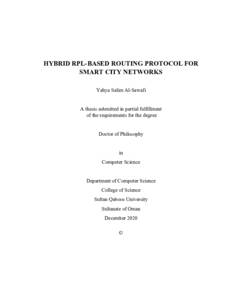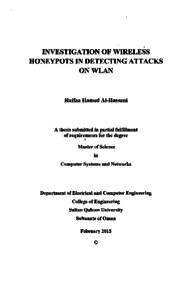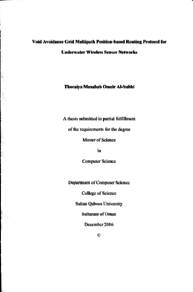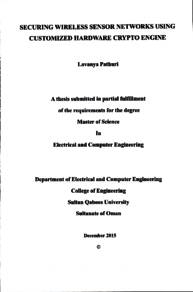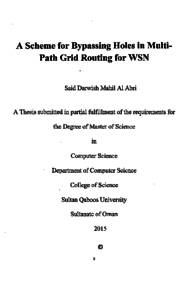Document
Hybrid RPL-based routing protocol for smart city networks.
Publisher
Sultan Qaboos University.
Gregorian
2020
Language
English
English abstract
Smart cities rely on monitoring information gathered by a large number of Wireless
Sensor Networks (WSN) for decision and policymaking. Recently, mobile crowd sensing
(MCS), leveraging smartphones, and vehicles' latest sensing and networking features, has
led to many new smart city monitoring applications. However, both WSN and MCS
sensing technologies come with their challenges. WSN faces network latency, limited
battery lifetime problems, security vulnerabilities, and limited capabilities due to
constrained small IoT devices. On the other hand, most current MCS applications use a
direct Internet connection to send the collected data to the server using 4G or 5G networks.
However, this will incur an extra cost in terms of data tariff, network bandwidth, and high
battery consumption. Many researches have focused on studying each of these sensing
paradigms as separate architectures. However, very few studies have considered the
integration between them (MCS-WSN). The integration will allow them to leverage their
advantages and overcome their drawbacks. Therefore, this thesis aims to address both
technologies' challenges by proposing a routing protocol implemented in both MCS and
WSN nodes and allowing integration between them. The thesis also proposes a new realtime Intrusion Detection System (IDS) based on deep learning that addresses some
security attacks that might happen at the WSN network.
We have first investigated the routing protocols used in the IoT and smart city domain, in
which the Routing Protocol for Low-Power and Lossy Networks (RPL) is selected as the
base of our proposed protocol. RPL is an IETF IPv6 standard routing protocol designed
for static WSN, and it is considered to be the primary routing protocol for IoT devices.
We have then proposed a routing protocol named MCS-RPL that runs on MCS nodes
utilizing smartphone sensing and communication capabilities. MCS-RPL uses a 2D gridbased clustering to address the RPL mobility issues and reduce control packets. Elected
cell-head sensor nodes are responsible for collecting data within their cells and forwarding
them in a cell-by-cell multi-hop manner to the sink node for analysis. The protocol
performance was evaluated against two known MANET routing protocols: AODV and
GPSR, as a baseline, and native RPL. The conducted performance evaluation reveals that
the proposed protocol outperforms the others regarding packet delivery ratio and overhead
packet reduction.
To further improve the protocol performance, we have proposed a context-aware routing
protocol that adapts to the dynamic node context in terms of status and mobility. The
proposed protocol uses a new cell-head selection technique and a dynamic trickle
algorithm to enhance the tree stability and further reduce the number of control packets,
end-to-end delay, and increase delivery ratio shown in the evaluation.
vi
We have then proposed a hybrid routing protocol that combines the two wireless sensing
technologies WSN and MCS, and allows the integration. The aim is to have an integrated
ad-hoc hybrid-sensing network that opportunistically uses MCS nodes to support static
WSN nodes to enhance the performance. The evaluation of the proposed protocol was
conducted in static WSN nodes to study the impact of the integration on the WSN
performance. The results reveal a good enhancement on packet delivery ratio (17 % more),
end-to-end delay (50% less), and power consumption (25% less) compared to native RPL
(without MCS integration).
We have designed and implemented simulation models for all the routing protocols and
conducted extensive simulation experiments using the OMNET++ simulation tool. We
have considered using different scenarios in those experiments by varying the network
density, nodes speed, and traffic load.
Finally, we have proposed an IDS system based on deep-learning to address the IoT
(WSN) networks' security challenge (attacks). The aim also not to transfer these threats to
other nodes such as MCS and RSUs when integrating with them. Due to the lack of
datasets designed for IoT traffics, we have contributed by developing a specialized IoTR
dataset to detect better and classify three common attacks (DIS, Rank, and Wormhole)
that target the RPL protocol. The IDS system then uses a hybrid deep learning technique
that combines supervised and semi-supervised approaches to classify known and
unknown anomaly behaviors within the dataset. The evaluation results show an accuracydetecting rate of 98% and 92% f1-score of multi-class attacks when using pre-trained
attacks (known) and an average accuracy of 95% and 87% f1-score when predicting
untrained two attack behaviors (unknown)
Member of
Resource URL
Category
Theses and Dissertations

